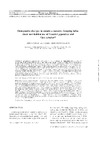Identificador persistente para citar o vincular este elemento:
https://accedacris.ulpgc.es/jspui/handle/10553/1029
| Título: | Ontogenetic changes in mouth structures, foraging behaviour and habitat use of Scomber japonicus and Illex coindetii | Otros títulos: | Cambios ontogenéticos en las estructuras bucales. Comportamiento alimenticio y uso de habitat en scomper japonicus e illex coindeti | Autores/as: | Castro Hernández, José Juan Hernández García, Vicente |
Clasificación UNESCO: | 3105 Peces y fauna silvestre | Palabras clave: | Ontogeny Mouth structures Caballa Migration Shifts, et al. |
Fecha de publicación: | 1995 | Publicación seriada: | Scientia Marina | Resumen: | The quick development of the skull structure is of vital importance to animals cluring the early stages of life given that herein are located the governing center and the mechanisms which make feeding possible. However, the rhythm of growth changes thoughout the life cycle. a process which is particularly manifest in the proportionate head/body growth. The mouth structures grow proportionately to heacl growth. These accentuated changes in the anatomy of the animal could be reflected in its behavioural pattern (migrations between two areas in the case of sorne species and significant changes in diet connecting to these migrations). Scomber japonicus (Pisces. Scombridae) and Illex coindetti (Cephalopoda. Ommastrephidae) both undergo significant changes in the rhythm of growth of their respective mouth structures when they reach arouncl 13-15 ancl 14-20 cm or total body length (mantle length in cephalopods) respectively. In Illex coindetti there are also differences by sex. being the changes or growth at 15 cm in males and around 20 cm in females. In both of these species. this change in the rhythm of growth implies a significant variation in diet as the consequence of a shift of habitat. El rápido desarrollo del cráneo es de importancia vital durante las primeras fases de la vida del animal. ya que en él está localizado el centro rector y las estructuras que hacen posible la alimentación. El ritmo de crecimiento cambia a lo largo del ciclo vital y esto es especialmente evidente en el crecimiento de la cabeza en relación al del cuerpo. Las estructuras bucales crecen de acuerdo con el crecimiento de la cabeza. Los cambios anatómicos acentuados pueden quedar también reflejados en el patrón de comportamiento del animal (un cambio significativo en la dieta y en algunas especies. en relación con estos cambios en la dieta. son las migraciones entre dos áreas diferentes). Scomber japonicus (Pisces. Scombriclae) e Illex coindetti (Cephalopoda. Ommastrephidae) sufren un cambio significativo en el ritmo de crecimiento de sus respectivas estructuras bucales: alrededor de l3-15 y 14-20 cm de longitud corporal (longitud dorsal del manto en cefalópodos) respectivamente. En I. coindetti hay también diferencias por sexos, siendo el cambio de ritmo de crecimiento a los 15 cm en machos y alrededor de los 20 cm en las hembras. En estas especies este cambio en el ritmo de crecimiento envuelve variaciones significativas en la dieta como consecuencia de un cambio de hábitat. |
URI: | https://accedacris.ulpgc.es/handle/10553/1029 | ISSN: | 0214-8358 | Fuente: | Scientia Marina [ISSN 0214-8358], v. 59 (3), p. 347-355 | URL: | http://dialnet.unirioja.es/servlet/articulo?codigo=2188600 |
| Colección: | Artículos |
Citas de WEB OF SCIENCETM
Citations
43
actualizado el 25-feb-2024
Visitas
154
actualizado el 30-nov-2024
Descargas
154
actualizado el 30-nov-2024
Google ScholarTM
Verifica
Comparte
Exporta metadatos
Los elementos en ULPGC accedaCRIS están protegidos por derechos de autor con todos los derechos reservados, a menos que se indique lo contrario.
